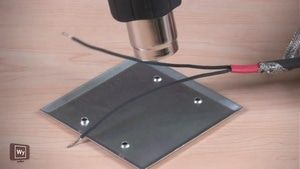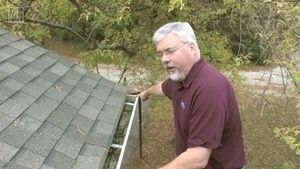
Ice Shield: Self-Regulating Roof and Gutter Deicing Systems Support
Common Support Questions
Do radiant heating products have polarity?
Electric-resistance heating cables and systems have no polarity. This includes all current WarmlyYours heating elements.
Need more help? View support options
Why a GFEP (GEFP, RCCB, or heat trace circuit breaker) and not a GFCI breaker for WarmlyYours outdoor deicing and snow melting systems?
This National Electric Code (NEC) required protection for fixed outdoor deicing and snow-melting equipment may be accomplished by using circuit breakers equipped with ground-fault equipment protection (GFEP) of 30 mA. It is important to understand that this required equipment protection is not the same as a 5 mA GFCI used for personal protection.
Solution:
Need more help? View support options
Can I run Roof and Gutter Deicing Cable off an extension cord?
NEVER use an extension cord. If you do not understand the electrical requirements needed regarding the electrical receptacle plug, contact your local electrical inspector or a licensed electrician.
The reason for this is due to safety and performance of the system. Extension cords are often not properly selected and will degrade, potentially leading to electrical shorts or other hazards such as fire. Roof de-icing cables are designed to be connected directly to a properly rated outlet, and the length and type of extension cords may not be rated for the same power load, leading to insufficient power supply, potential damage to the cables, and further safety risks including their ability to prevent ice dams on your roof.
Need more help? View support options
What is the lifespan of WarmlyYours roof and gutter deicing cables?
WarmlyYours roof and gutter deicing self-regulating cable loses its power ramp-up ability at about 5-10 years, but it will still work at its rated wattage for years. Properly installed WarmlyYours roof and gutter constant wattage cable usually lasts well beyond its warranty period.
Need more help? View support options
What type of roofs can I use WarmlyYours Self-Regulating cable on?
WarmlyYours self-regulating cable is suitable for use on standard asphalt or wood shingles, angled cedar, tile or terra cotta, slate, flat membrane-type (rubber or EPDM) roofing, and metal roofing. For attaching, the same clips are used for both slate and cedar roofing. Always check local codes for approved methods of heating roofs and gutters.
Need more help? View support options
Can I install a roof and gutter deicing system on a 'ribbed' metal roof?
WarmlyYours does not recommend installing de-icing systems on ribbed metal roofs. This is because ribbed metal roofs typically aren’t flat enough for attachment of the mounting pads or proper contact of the cables with the roof.
Need more help? View support options
Can WarmlyYours self-regulating cable go in liner drains in the driveway? In front of the garage and the end of a driveway?
WarmlyYours self-regulating cable can rest in the bottom of the drain. Some people put them on the AIR-STAT to control operation.
Need more help? View support options
Can WarmlyYours self-regulating deicing cable be used inside a drain pipe or trench?
Yes, WarmlyYours self-regulating deicing cable may be used in a drain opening or in a trench. It cannot go inside a pipe.
Need more help? View support options
Can self-regulating cable be installed on EPDM or rubber roofs?
WarmlyYours self-regulating roof and gutter de-icing cable can be used on rubber or EPDM (Ethylene Propylene Diene terpolyMer) roofs.
The primer that WarmlyYours sells is specifically for adhering clips to EPDM or rubber roofing.
Need more help? View support options
How far apart are the triangles spaced from one another at the roof edge near the gutter for WarmlyYours self-regulating deicing cable?
Triangles are spaced 24" apart.
Need more help? View support options
I have leaf guards installed on my gutters. Can I attach the deicing system to the side, or underside of my gutters?
No, typically leaf guards need to be removed for the deicing cable to be installed in the gutter to work effectively.
Need more help? View support options
Is self regulating cable good for clearing snow off my roof?
Self Regulating cable is not designed for snow load removal. It is designed for deicing in scuppers, roof overhangs, gutters, downspouts, trench drains, etc.
Need more help? View support options
Once we installed the Self-Regulating cable and plugged it in, we noticed it was heating. Doesn't this self-regulate and not turn on until is is cold?
Self-regulating cable heats to the specified watts per linear foot when energized
Need more help? View support options
The neutral on GFEP/GEFP/RCCB 240V breakers is not used, why do I need this then?
A 2 pole single-phase 240V circuit works by continuously monitoring the current flowing through both hot wires of the circuit. If it detects even a slight imbalance between the current on each hot wire (indicating a ground fault), it will quickly trip, cutting off power to the circuit. Essentially, it compares each leg of the 240V circuit and trips if they are not precisely equal.
Need more help? View support options
What are some considerations to note about WarmlyYours roof and gutter deicing self-regulating cable versus constant wattage cable?
- Overlapping WarmlyYours self-regulating cable is possible because self-regulating cable regulates heat output to prevent overheating and damaging the cable.
- Overlapping WarmlyYours constant wattage cable is not possible because it is on all the time and cannot come in contact with itself or any other constant wattage heating cable, as it will overheat and fail.
- Self-regulating cable requires the use of a control and/or a sensor to operate. WarmlyYours offers a variety of controls ranging from a basic manual control to our premium option that provides the ultimate in convenience and hands-off operation.
- Constant wattage cable does not require a thermostat/controller and can be connected to an outlet throughout an entire winter, during a single snow event, or whenever deicing is needed. An optional plug-in thermostat can be used if desired.
- Self-regulating cable is designed to be cut to length at the jobsite by an installer where it can then be end-capped with accessories (sold separately).
- Constant wattage cable cannot be shortened or altered in any way.
Need more help? View support options
What is the difference between Self-Regulating and Constant Wattage Cabling?
As the names imply, constant wattage cable uses fixed wattage output per linear foot and does not automatically adjust in response to temperature changes. Self-regulating cable is manufactured with a resistance matrix placed between its 2 buss wires that varies the ohms resistance per linear foot to automatically adjust in response to temperature changes. Learn more about this in our blog Self-Regulating vs. Constant Wattage Heating Cables.
Need more help? View support options
Publications and Manuals
General Publications
Gutter Ice Sensor Spec Sheet (English)Gutter/Aerial Ice and Snow Sensor Spec Sheet (English)
Installation
Roof And Gutter Cable Installation Manual (English)ET-End-Kit End Seal Kit Installation Manual (English)
Gutter Ice Sensor Installation (English)
SR-PLUG-KIT Plug-in Conversion Kit with Ground Fault Equipment Protection (GFEP) Installation Manual (English)
SR-PWR-Kit Power Connection Kit Installation Manual (English)
Project Planners
Roof / Gutter Deicing Quotation Form (English)Snow Melting Roof Deicing Infographic (English)
Sell Sheets
Ice Shield Self-Regulating Roof & Gutter Deicing Cable Sell Sheet Canada (English)Outdoor Display Program Sell Sheet for Canada (English)
Videos
Product Line Videos


Tech Tips: How to Test Self Regulating Cables

How to Terminate a Self-Regulating Cable for Roof & Gutter or Pipe Freeze Protection Systems

Electric Outdoor Heating for Roof & Gutters Installation Overview

Installing WarmlyYours Roof and Gutter De-icing System on a Slate Roof with A Concord Carpenter

Why and How to Install a Roof & Gutter De-Icing System
Articles
De-Icing Ribbed Metal Roofing
Double-sided tape for roof and gutter clips Fail, Rolled Roof
Roof and Gutter not suitable for snow load removal
Roof Gutter Cable Triangle Width
SCE-AMB-SS Sensor wiring (OJ ETF-7)
Why starting current of self regulating cable is higher than operating current?